
Continuous track or tracked treads are a system of vehicle propulsion used in tracked vehicles, running on a continuous band of treads or track plates driven by two or more wheels. The large surface area of the tracks distributes the weight of the vehicle better than steel or rubber tyres on an equivalent vehicle, enabling continuous tracked vehicles to traverse soft ground with less likelihood of becoming stuck due to sinking.

Starlight Express is a 1984 musical, with music by Andrew Lloyd Webber and lyrics by Richard Stilgoe. It tells the story of a young but obsolete steam engine, Rusty, who races in a championship against modern engines in the hope of impressing a first-class observation car, Pearl. Famously, the actors perform on roller skates.
The Little Engine That Could is an American folktale that became widely known in the United States after publication in 1930 by Platt & Munk. The story is used to teach children the value of optimism and hard work. Based on a 2007 online poll, the National Education Association listed the book as one of its "Teachers' Top 100 Books for Children".

A Nightmare on Elm Street is an American supernatural slasher media franchise consisting of nine films, a television series, novels, comic books, and various other media. The franchise began with the film A Nightmare on Elm Street (1984), written and directed by Wes Craven. The overall plot of the franchise centers around the fictional character Fred "Freddy" Krueger, the apparition of a former child killer who was burned alive by the vengeful parents of his victims, who returns from the grave to terrorize and kill the teenage residents of the fictional Springwood, Ohio in their dreams. Craven returned to the franchise to co-script the second sequel, A Nightmare on Elm Street 3: Dream Warriors (1987), and to write/direct Wes Craven's New Nightmare (1994). The films collectively grossed $472 million at the box office worldwide.

The Railway Series is a series of British books about a railway known as the North Western Railway, located on the fictional Island of Sodor. There are 42 books in the series, the first published in May 1945 by the Rev. Wilbert Awdry. Twenty-six books were written by Awdry, the final one being written in October 1972. Sixteen more were written by his son, Christopher Awdry, between September 1983 and July 2011. The series features many anthropomorphic vehicles, including Thomas the Tank Engine. Thomas became the most popular and famous character in the series and the titular character of the television series Thomas & Friends from 1984 to 2021. The children's television series originated as adaptations of these stories.
Diesel locomotives have seen limited use on the London Underground, largely because exhaust gases cannot be discharged when the vehicles are working in tunnels. A prototype diesel engine numbered DEL120 was built in 1939 from two 1915 stock motor cars, which was expected to be part of a batch of ten, but experience with battery locomotives showed that these were a better alternative. Three 0-6-0 diesels (DL81-DL83) were obtained in 1971, to replace the last steam engines, but were too short to operate the signalling system, and too heavy for some of the bridges. In 1996, fourteen diesels were supplied by Schöma of Germany, which were used during the construction of the Jubilee line tunnels. They were fitted with exhaust scrubbers, to enable them to work in the tunnels. To speed up track renewals on the subsurface lines, Class 66 locomotives have been hired in since 2006 to handle permanent way trains, but again suffer from being too heavy for some of the bridges. Because they are not fitted with tripcock safety devices, and pull trains much longer than the signalling system is designed for, they are restricted to slow speed running.

Rubbadubbers is a British stop-motion children's television series produced by HIT Entertainment and HOT Animation. The series was broadcast in the UK on BBC2 and CBeebies from 2002 to 2005. Created by Peter Curtis, it focuses on seven friendly, sentient bath toys as they tell stories in imaginary worlds outside of their bathroom - the ringleader in the series being a pink frog named Tubb. In the US, the series was broadcast on Nickelodeon, Noggin and PBS Kids Sprout.
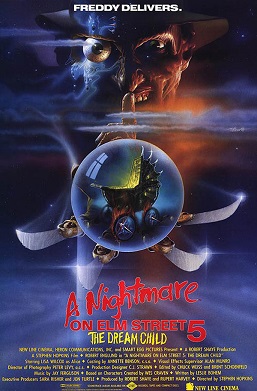
A Nightmare on Elm Street 5: The Dream Child is a 1989 American gothic slasher film directed by Stephen Hopkins and written by Leslie Bohem. It is the fifth installment in the A Nightmare on Elm Street franchise, and stars Lisa Wilcox, and Robert Englund as Freddy Krueger. The film follows Krueger, using a now pregnant Alice Johnson's baby's dreams to claim new victims.
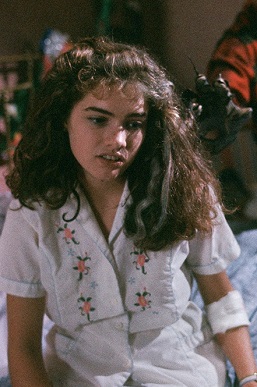
Nancy Thompson is a fictional character in the A Nightmare on Elm Street franchise. She first appears in A Nightmare on Elm Street (1984) as a teenager hunted in her dreams by enigmatic serial killer Freddy Krueger. In this film, she was portrayed by Heather Langenkamp—who reprises the role in the sequel, A Nightmare on Elm Street 3: Dream Warriors (1987). Langenkamp later portrayed a fictional version of herself who embodies the role of Nancy in Wes Craven's New Nightmare (1994). A reimagined version of the character, Nancy Holbrook, is portrayed by Rooney Mara in the 2010 remake.
".007" is a short story by Rudyard Kipling. It is a story in which steam locomotives are characters, somewhat like the later, better-known tales of The Railway Series by Wilbert Awdry and his son.
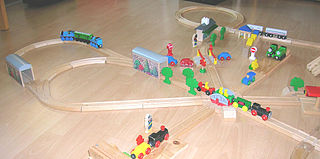
Wooden toy trains are toy trains that run on a wooden track system with grooves to guide the wheels of the rolling stock. While the trains, tracks and scenery accessories are made mainly of wood, the engines and cars connect to each other using metal hooks or small magnets, and some use plastic wheels mounted on metal axles. Some trains are made to resemble anthropomorphical, fictional, and prototypical railroad equipment.

The Busy Little Engine is a 2005 direct-to-video children's film written and directed by Desmond Mullen. It was selected for the 2006 San Diego International Children's Film Festival and reviewed in the professional library journals Booklist, School Library Journal, and Video Librarian. The Busy Little Engine was picked Best DVD by Parenting Magazine in July 2006.
The Meon Valley Railway was a cross-country railway in Hampshire, England, that ran for 22 miles (36 km) between Alton and Fareham, closely following the course of the River Meon. At its northern (Alton) end, it joined with the Alton Line from London. It was conceived as an additional main line to the area around Gosport, and it was opened in 1903. It never fulfilled its planned potential, and remained a local line through sparsely populated agricultural areas, and it closed to passenger services in 1955; some local goods services continued until total closure in 1968.

Day Out with Thomas is a trade name, licensed by Mattel for tourist events that take place on heritage railways and feature one or more engines decorated to look like characters from the popular long-running classic British children's television series. The events are held around the world in Australia, Canada, Japan, the Netherlands, New Zealand, the United Kingdom, and the United States of America. They include a full-day of activities for families in addition to rides on trains pulled by the iconic engine (Thomas).
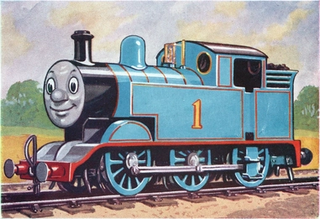
Thomas the Tank Engine is an anthropomorphised fictional tank locomotive in the British Railway Series books by Wilbert Awdry and his son, Christopher, published from 1945. He became the most popular and famous character in the series, and is the titular protagonist in the accompanying television adaptation series Thomas & Friends and its reboot Thomas & Friends: All Engines Go.

Rodney Saulsberry is an American voice-over performer, actor, vocalist, announcer and author, known for his voice work on commercials, his three books You Can Bank on Your Voice, Step Up to the Mic, Rodney Saulsberry's Tongue Twisters and Vocal Warm-Ups, the host of the popular podcast Success Talks With Rodney Saulsberry and the voice of Robbie Robertson in the 1994 animated TV series Spider-Man.

The Caboose Who Got Loose is a children's picture book written and illustrated by Bill Peet, published in 1971 by Houghton Mifflin.

Thomas & Friends is a media franchise created by Rev. W. Awdry and Britt Allcroft. The franchise revolves around a railway, called the North Western Railway, located on the fictional Island of Sodor. The current title character of the franchise is Thomas the Tank Engine, an anthropomorphised steam locomotive, who works with other engines, including Edward, Henry, Gordon, James, Percy, Toby and many others. The franchise began with stories told from Wilbert Awdry to his son. In 1984, it was turned into a television series, which spawned a reboot series, titled Thomas & Friends: All Engines Go.
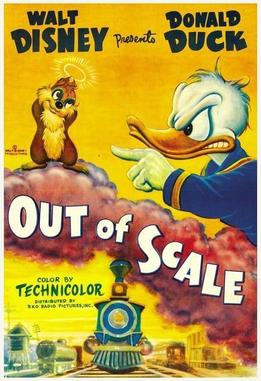
Out of Scale is a 1951 American animated short film directed by Jack Hannah and produced by Walt Disney. In the short, Donald Duck has a ride-on sized train layout in his backyard. There's a large tree that's out of scale, so Donald moves it while they are out; they come back to see their tree moving. The chipmunks realise that one of Donald's model houses is perfect for their size.
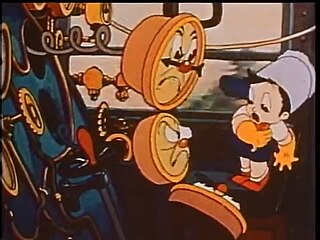
Play Safe is a 1936 animated short film produced by Fleischer Studios and released by Paramount Pictures. This film was part of Max Fleischer's Color Classics series. The film follows the story of a boy who has a dream about being on a real train.
















